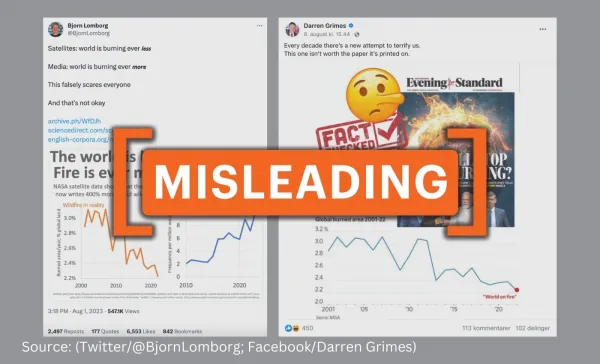By: Nikolaj Kristensen
August 11 2023

The global burned area has decreased, but some regions are experiencing more wildfires, and increasing forest areas are lost to fire.
Context
According to posts on social media, wildfires are affecting the world less and less. The posts include graphs showing that the area wildfires burn yearly has declined over the past couple of decades, usually paired with claims of climate alarmism.
While it is true that the world is generally seeing a decline in burned areas, this is not true for all places, nor all types of land. The United States, for example, has seen an increase in wildfires, and an increasing amount of forest is being lost to fire every year, contributing further to climate change.
In fact
That the global area burned – as mapped by satellites – is declining was first documented in a paper published in Science in 2017. One of the authors of that paper, Douglas Morton, chief of the Biospheric Sciences Laboratory at NASA’s Goddard Space Flight Center and adjunct professor at the University of Maryland told Logically Facts that, according to the NASA satellites, there has been a decline in burned area of 1 percent per year for more than 20 years now.
Asked how that could be when global average temperatures are rising, Morton said that while climate change creates more flammable conditions, opposing trends are at play. “The short answer to this apparent contradiction is that burned area is declining in savannas and grasslands, and this decline is not offset by evidence for increasing fire activity in forests and shrublands over the past two decades,” explained Morton.
There are regions where the burned areas are increasing, not declining. One such place is the United States, which has seen an increase in the extent of wildfires.
The graphs shared on social media are a form of cherry-picking and fail to contextualize data, Jens Hesselbjerg Christensen and Larissa van der Laan, climate scientists at the University of Copenhagen, told Logically Facts.
“Sure, there’s been a decrease in newly burned areas, but the consequences of the fires that do happen are getting worse,” they state.
They point to three disconcerting developments all happening at once. “Firstly, the interface between wild areas and inhabited areas is growing, increasing the risk of ignition and increasing the effect that fires will have on people and infrastructure.”
The second development is that while the overall reduction is largely driven by a considerable decline in fires in the savannas of Africa, there has been more burning of forests. Over the last two decades, there has been an increase in forest loss due to fires, contributing further to climate change.
For the third development, Christensen and van der Laan point to a recent review article on fire and climate change. “Climate change is exerting a pervasive upwards pressure on fire globally by increasing the frequency and intensity of fire weather, and this upwards pressure will escalate with each increment of global warming,” it says in the paper.
The verdict
While true that the world as a whole is seeing fewer burned areas, this is not true for all regions. In places like the United States, the extent of wildfires is increasing. More and more forest is being lost, and as inhabited areas are expanding into the wild, risks of ignition and the harms connected with wildfires are increasing. Meanwhile, climate change is exerting upward pressure on fire globally by increasing the frequency and intensity of weather conditions fit for fires to happen. The posts on social media do not take any of this into account. Therefore, we have marked this claim as misleading.